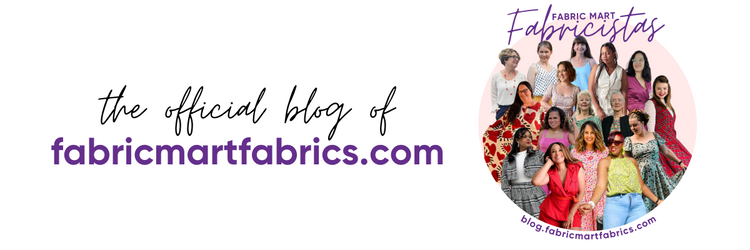Hello everyone! It’s Sharon back with my second Fabricista post! This time I chose to work with a lovely soft pastel plaid shirting fabric.
The big shirt trend has been popular for a season or two and, according to recent fashion articles I’ve read, it will remain popular throughout the summer.
This lightweight fabric, a cotton/polyester blend, had the structure to work beautifully as an oversized shirt. I don’t typically wear classic button front shirts, so of course I choose to sew one with a little “extra”!
Vogue 1744 looks like a tailored button front shirt from the front, but the pleated back provides interest and movement. By the way, this pattern was rebranded in 2020, and had been previously released as Vogue 9360. I sewed View D, the mandarin collar option, with short sleeves and hi-low hem.
This particular plaid is an uneven plaid. If you’re unsure whether your plaid is even or uneven, here’s how to test (according to my Vogue Sewing Book c. 1975). "Fold the fabric diagonally through the center of any repeat, making sure the plaid is perfectly on grain. If spaces and colors match, test further by folding the plaid vertically or horizontally though the center of any repeat. In an even plaid the spaces and colors match in both directions. In an uneven plaid the spaces and colors do not match in both directions.”
Since I was working with a plaid, I cut my pattern pieces face-up on the right side of a single layer of fabric. Because this was an uneven plaid, I used a one-way layout. I was careful to match my stitching lines, not my cutting lines.
I choose to match the plaids horizontally so when the shirt was buttoned the horizontal line would be unbroken.
I cut the pleated back on the bias and added an overlay of lace on the back yoke. The bias doesn’t have to match at the side seams, and lace distracts the eye enough that the plaid doesn't need to be matched at the shoulder or armhole seam. My hair is long enough that the yoke is covered when I wear the shirt, but I pulled my hair forward so you can see the yoke. Both of those are little tricks I use when I don’t want to spend a lot of time matching the plaid on my pattern pieces, ha-ha.
I pre-washed and dried the fabric, as I do with every fabric purchase, and it came out of the dryer perfectly. I love that I won’t need to iron this shirt.
I used a narrow three-thread stitch on my serger to finish all of the seams, and also to finish the bottom edge before turning under and stitching in place.
The beauty of this big shirt is I can pair it with jeans, white pants, or add a cardi and wear it open like a cardigan. It’s the perfect button front shirt for summer!
SHARON | @thesharonsews
Unfortunately Fabric Mart Fabrics sell out quickly!
You can find similar fabrics by shopping the following category SHIRTING.










Lovely and comfortable!
ReplyDeleteSuch a cute summer top.
ReplyDeleteWow! I love this shirt. And your ideas for the back view are such a simple way to solve a problem that I am surprised that RTW hasn’t copied it. I especially love the idea of lace on the yoke and who doesn’t love plaid on the bias. Again, WOW! I love this shirt. It looks great on you. Thanks for sharing your inspiration.
ReplyDeleteThat’s a beautiful shirt! I never would have thought of making something like that.
ReplyDelete